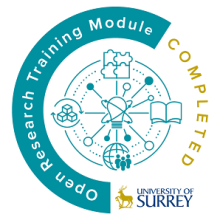
Claire Price
Academic and research departments
Faculty of Health and Medical Sciences, School of Health Sciences.About
My research project
Improving predictive validity of tumour markers: Developing and validating predictive models using a large United Kingdom primary care databaseIn this project, routinely collected NHS data from one if the UK’s largest primary care databases Orchid will be used to develop and validate predictive models for more accurate diagnoses of cancers. This will improve the understanding of the predictive value of tumour markers in relation to clinically relevant outcomes – e.g. the need for treatment. In the future, this could improve the usage of NHS resources and patient care.
Supervisors
In this project, routinely collected NHS data from one if the UK’s largest primary care databases Orchid will be used to develop and validate predictive models for more accurate diagnoses of cancers. This will improve the understanding of the predictive value of tumour markers in relation to clinically relevant outcomes – e.g. the need for treatment. In the future, this could improve the usage of NHS resources and patient care.
My qualifications
Affiliations and memberships
Publications
Pancreatic cancer is a devasting disease which is an increasing cause of cancer mortality. The aim of this study was to characterise, using descriptive statistics, the sociodemographic, risk and clinical characteristics of who develops pancreatic cancer. This retrospective cohort study examined data from one of the largest UK primary care databases, from January 1st 2006 to August 31st 2020. A total of 573 primary care practices contributed data. There were 9,267 people diagnosed with pancreatic cancer. The median age at diagnosis was 73 years (IQR 16) and 49.8% (4,616) of people were female. Nearly a third (30.2%, 2,798) of people had diabetes, and 85.8% (2,400) of the people with diabetes received the diabetes diagnosis before pancreatic cancer. For people for whom ethnicity was recorded 94.4% (5,979) were white. Under half of people with BMI recorded (41.9%, 571) were overweight or obese at pancreatic cancer diagnosis and 5.9% (80) were underweight. In addition, 12.6% (1,168) of participants were active smokers and 1.4% (130) exceeded recommended limits of alcohol. Improved characterisation of the sociodemographic, risk and clinical characteristics of who develops pancreatic cancer highlights the opportunity for machine learning and other technologies to flag people at high risk of this cancer.
Background: Antibiotic resistance increasingly threatens the interconnected health of humans, animals, and the environment. While misuse of antibiotics is a known driver, environmental factors also play a critical role. A balanced One Health approach—including the environmental sector—is necessary to understand the emergence and spread of resistance. Methods: We systematically searched English-language literature (1990–2021) in MEDLINE, Embase, and Web of Science, plus grey literature. Titles, abstracts, and keywords were screened, followed by full-text reviews using a structured codebook and dual-reviewer assessments. Results: Of 13,667 records screened, 738 met the inclusion criteria. Most studies focused on freshwater and terrestrial environments, particularly associated with wastewater or manure sources. Evidence of research has predominantly focused on Escherichia coli and Pseudomonas spp., with a concentration on ARGs conferring resistance to sulphonamides (sul1–3), tetracyclines (tet), and beta-lactams. Additionally, the People’s Republic of China has produced a third of the studies—twice that of the next country, the United States—and research was largely domestic, with closely linked author networks. Conclusion: Significant evidence gaps persist in understanding antibiotic resistance in non-built environments, particularly in marine, atmospheric, and non-agricultural set65 tings. Stressors such as climate change and microplastics remain notably under-explored. There is also an urgent need for more research in low-income regions, which face higher risks of antibiotic resistance, to support the development of targeted, evidence-based interventions.
Introduction: Overall cancer survival has increased over the recent decades, but the dismal survival rates of pancreatic cancer have hardly changed in the last 50 years. This is attributed to late diagnosis. Early pancreatic cancer symptoms are non-specific which makes diagnosis challenging. Data-driven approaches, including prediction algorithms that use a combination of symptoms, have been developed to aid earlier detection and diagnosis. One such algorithm is ENDPAC (Enriching New-Onset Diabetes for Pancreatic Cancer). ENDPAC was developed is the US primary care setting. The aim of this project is to validate ENDPAC for the UK setting and make invisible cases of pancreatic cancer visible using routinely collected healthcare data. Methods: A retrospective case-control study using the nationally representative Oxford-Royal College of General Practitioners Clinical Informatics Digital Hub (ORCHID) database will be undertaken. ORCHID holds over 10 million primary care electronic healthcare records including nearly 14,000 people diagnosed with pancreatic cancer (cases). Healthcare records of cases will be compared with matched controls and the predictive power of ENDPAC for the detection of pancreatic cancer will be evaluated. Discussion: Routinely collected primary care data are a rich resource that should be used to improve healthcare. However, they are currently underutilised in research due to restricted access as well as privacy and ethical implications. Using a trusted research environment to conduct analysis ensures data security and privacy. The validation of ENDPAC will serve as a case study to support the safe and trustworthy use of patient data in research. Conclusion: Data-driven algorithms using routine primary healthcare data may be an inexpensive and systematic approach to enhance identifying individuals who are at high-risk of conditions that would benefit from additional screening. Thorough validation is required to ensure these tools are fit for purpose before they can be adopted in clinical practice.
Introduction Worldwide, pancreatic cancer has a poor prognosis. Early diagnosis may improve survival by enabling curative treatment. Statistical and machine learning diagnostic prediction models using risk factors such as patient demographics and blood tests are being developed for clinical use to improve early diagnosis. One example is the Enriching New-onset Diabetes for Pancreatic Cancer (ENDPAC) model, which employs patients’ age, blood glucose and weight changes to provide pancreatic cancer risk scores. These values are routinely collected in primary care in the UK. Primary care’s central role in cancer diagnosis makes it an ideal setting to implement ENDPAC but it has yet to be used in clinical settings. This study aims to determine the feasibility of applying ENDPAC to data held by UK primary care practices. Methods and analysis This will be a multicentre observational study with a cohort design, determining the feasibility of applying ENDPAC in UK primary care. We will develop software to search, extract and process anonymised data from 20 primary care providers’ electronic patient record management systems on participants aged 50+ years, with a glycated haemoglobin (HbA1c) test result of ≥48 mmol/mol (6.5%) and no previous abnormal HbA1c results. Software to calculate ENDPAC scores will be developed, and descriptive statistics used to summarise the cohort’s demographics and assess data quality. Findings will inform the development of a future UK clinical trial to test ENDPAC’s effectiveness for the early detection of pancreatic cancer. Ethics and dissemination This project has been reviewed by the University of Surrey University Ethics Committee and received a favourable ethical opinion (FHMS 22-23151 EGA). Study findings will be presented at scientific meetings and published in international peer-reviewed journals. Participating primary care practices, clinical leads and policy makers will be provided with summaries of the findings.
Background Weight loss, hyperglycaemia and diabetes are known features of pancreatic cancer. We quantified the timing and the amount of changes in body mass index (BMI) and glycated haemoglobin (HbA1c), and their association with pancreatic cancer from five years before diagnosis. Methods A matched case-control study was undertaken within 590 primary care practices in England, United Kingdom. 8,777 patients diagnosed with pancreatic cancer (cases) between 1st January 2007 and 31st August 2020 were matched to 34,979 controls by age, gender and diabetes. Longitudinal trends in BMI and HbA1c were visualised. Odds ratios adjusted for demographic and lifestyle factors (aOR) and 95% confidence intervals (CI) were calculated with conditional logistic regression. Subgroup analyses were undertaken according to the diabetes status. Results Changes in BMI and HbA1c observed for cases on longitudinal plots started one and two years (respectively) before diagnosis. In the year before diagnosis, a 1 kg/m2 decrease in BMI between cases and controls was associated with aOR for pancreatic cancer of 1.05 (95% CI 1.05 to 1.06), and a 1 mmol/mol increase in HbA1c was associated with aOR of 1.06 (1.06 to 1.07). ORs remained statistically significant (p < 0.001) for 2 years before pancreatic cancer diagnosis for BMI and 3 years for HbA1c. Subgroup analysis revealed that the decrease in BMI was associated with a higher pancreatic cancer risk for people with diabetes than for people without (aORs 1.08, 1.06 to 1.09 versus 1.04, 1.03 to 1.05), but the increase in HbA1c was associated with a higher risk for people without diabetes than for people with diabetes (aORs 1.09, 1.07 to 1.11 versus 1.04, 1.03 to 1.04). Conclusions The statistically significant changes in weight and glycaemic control started three years before pancreatic cancer diagnosis but varied according to the diabetes status. The information from this study could be used to detect pancreatic cancer earlier than is currently achieved. However, regular BMI and HbA1c measurements are required to facilitate future research and implementation in clinical practice.

